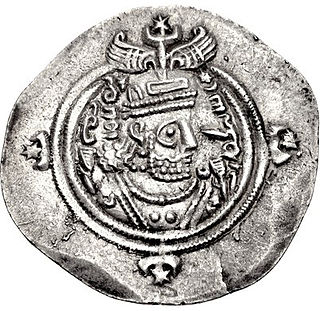
Hormizd IV, was king of the Sasanian Empire from 579 to 590. He was the son and successor of Khosrow I.

Yazdegerd III, was the last king (shah) of the Sasanian Empire from 632 to 651. His father was Shahriyar and his grandfather was Khosrow II.

Ardashir III, was king of the Sasanian Empire from 6 September 628 to 27 April 630.

Shahrbaraz or Shahrvaraz was king of the Sasanian Empire from 27 April 630 to 9 June 630. He usurped the throne from Ardashir III, and was killed by Sasanian nobles after forty days. Before usurping the Sasanian throne he was a general (spahbed) under Khosrow II (590–628). He is furthermore noted for his important role during the climactic Byzantine–Sasanian War of 602–628, and the events that followed afterwards. His name Shahrbaraz is actually an honorific title, and means "the Boar of the Empire", attesting to his dexterity in military command and his warlike personality, as the boar was the animal associated with the Zoroastrian Izad Vahram, the epitome of victory.

Boran was queen (banbishn) of the Sasanian Empire. She was the daughter of emperor Khosrow II, and the first of only two women to rule the Sasanian Empire; the other was her sister and successor, Azarmidokht. Various authors place her reign between one year and four months to two years.

Rostam Farrokhzād was an Iranian nobleman from the Ispahbudhan family, who served as the spahbed of Adurbadagan and Khorasan during the reign of Boran and Yazdegerd III. Rostam is remembered as a historical figure, a character in the Persian epic poem Shahnameh, and as a touchstone of most Iranian nationalists.

Bahrām Chōbīn or Wahrām Chōbēn, also known by his epithet Mihrevandak, was a nobleman, general, and political leader of the late Sasanian Empire and briefly its ruler as Bahram VI.

Azarmidokht was queen (banbishn) of the Sasanian Empire from to 630 to 631. She was the daughter of shah Khosrow II. She was the second Sasanian queen; her sister Boran ruled before and after Azarmidokht. Azarmidokht ruled the Sasanian Empire after her cousin Shapur-i Shahrvaraz was deposed.
Hormuzan was an Iranian aristocrat who served as the governor of Khuzestan, and was one of the Sasanian military officers at the Battle of al-Qādisiyyah. He was later taken prisoner by the Muslims after the fall of Shushtar in 642. Two years later, he was accused of the assassination of the Rashidun caliph Umar, and was killed by 'Ubaid-Allah, the deceased caliph's son.
Farrukhzad, was an Iranian aristocrat from the House of Ispahbudhan and the founder of the Bavand dynasty, ruling from 651 to 665. Originally a powerful servant of the Sasanian king Khosrow II, he, along with several other powerful aristocrats made a conspiracy against the latter and ended his tyrannical rule. They thereafter put Khosrow's son Kavadh II on the throne, whose rule lasted only a few months, before he was killed by a plague, being succeeded by his son Ardashir III, who was only after one year murdered by the rebellious former Sasanian army chief (spahbed) Shahrbaraz, who usurped the throne.

The Sasanian civil war of 589-591 was a conflict that broke out in 589, due to the great deal of dissatisfaction among the nobles towards the rule of Hormizd IV. The civil war lasted until 591, ending with the overthrow of the Mihranid usurper Bahram Chobin and the restoration of the Sasanian family as the rulers of Iran.

Farrukh Hormizd or Farrokh Hormizd, also known as Hormizd V, was a spahbed in northern Persia, he was a prince of Atropatene. He later came in conflict with the Sassanid nobles, "dividing the resources of the country". He was later killed by Siyavakhsh in a palace plot on the orders of Azarmidokht after he proposed to her in an attempt to usurp the Sasanian throne. He had two children, Rostam Farrokhzād and Farrukhzad.
Piruz Khosrow, also known as Piruzan or Firuzan, was a powerful Persian aristocrat who was the leader of the Parsig (Persian) faction that controlled much of the affairs of the Sasanian Empire during the Sasanian civil war of 628-632. He was killed at the Battle of Nahāvand in 642.
Mah-Adhur Gushnasp, also known by the Arabicized form of Mahadharjushnas, was an Iranian nobleman who served as the wuzurg framadār of the Sasanian Empire during the reign of the child ruler Ardashir III.
Narsi or Narse, was an Iranian nobleman who served as the Sasanian governor of Kashkar.


















